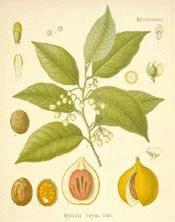
Botanical.com Home Page

|
Nutmeg
(Myristica fragrans HONK.)
Click on graphic for larger image
|
Mace
Botanical: Myristica fragrans (HONK.)
Family: N.O. Myristicaceae
---Synonyms---Arillus Myristicae. Myristica officinalis. Myristica moschata. Macis. Muscadier.
---Part Used---The dried arillus of the fruit or nutmeg.
---Habitat---Moluccas and Bandy Islands, New Guinea, West Indies, etc.
---History---The name is derived from a mediaeval word for 'nut,' meaning 'suitable for an ointment.' The tree is a small evergreen, not more than 40 feet in height, with smooth, greyish-brown bark, green on the younger branches. The alternate leaves are oblong-ovate, acute, entire, smooth, and dark-green. The flowers are very small and unisexual. The fruits, smooth and yellow, resemble a pear grooved by a longitudinal furrow and contain a single erect seed about 1 1/4 inch long, the nucleus being the wrinkled 'nutmeg,' and the fleshy, irregular covering, scarlet when fresh and drying yellow and brittle, the 'mace.'
The principal harvest at Bencoolen is usually in the autumn, the smaller one in early summer. The fruits, which split open when ripe, are gathered with a long-handled hook and the products are separated. The mace when dried is often sprinkled with salt water to preserve it. If packed too moist it breeds worms.
Most of the supply comes from the Banda Islands by way of Java and Sumatra.
The 'blades,' 'bands,' or flattened, lobed pieces are about 25 mm. long, smooth, irregular, translucent, brittle or flexible, and if scratched or pressed exude an orangecoloured oil.
An inferior Mace is obtained from the long nutmeg, dark and very brittle and lacking the fragrant odour and aromatic taste of the official variety.
The medicinal properties resemble those of nutmeg, but it is principally used as a condiment.
---Constituents---The principal constituent is 7 to 9 per cent of a volatile oil, protein, gum, resins, sugar and fixed oil. The volatile oil contains much pinene, and a little myristicin, which must be distinguished from the glyceride of myristic acid.
Two odorous fixed oils have been separated, a yellow one insoluble in boiling alcohol but soluble in ether, and a red one soluble in either.
The powder is brown or buff, orangetinted.
Oil of Mace is practically identical with distilled oil of nutmeg or Nutmeg Butter.
---Medicinal Action and Uses---A flavouring agent, stimulant and tonic.
Both Mace and Nutmeg help digestion in stomachic weakness, but if used to excess may cause over-excitement. They increase circulation and animal heat. They have been employed in pestilential and putrid fevers, and with other substances in intermittent fevers, and enter into the composition of many French medicaments.
---Dosage---5 to 20 grains.
---Other Species---
Myristica malabarica, yielding Bombay Mace, which is deficient in odour and taste. Several chemical tests provide means of detecting the substitution. It yields a much higher percentage of ether-soluble matter.
M. argentea, yielding Macassar Mace, which is of a dull brown colour with an odour like sassafras. It is too acrid for medicinal use.
M. otoba, yielding a Mace which, incorporated with fat, is used in gout and rheumatism.
See NUTMEG.
[Top]
Common Name Index
A MODERN HERBAL Home Page
Bear in mind "A Modern Herbal" was written with the conventional wisdom of the early 1900's. This should be taken into account as some of the information may now be considered inaccurate, or not in accordance with modern medicine.
© Copyright Protected 1995-2025 Botanical.com
|

